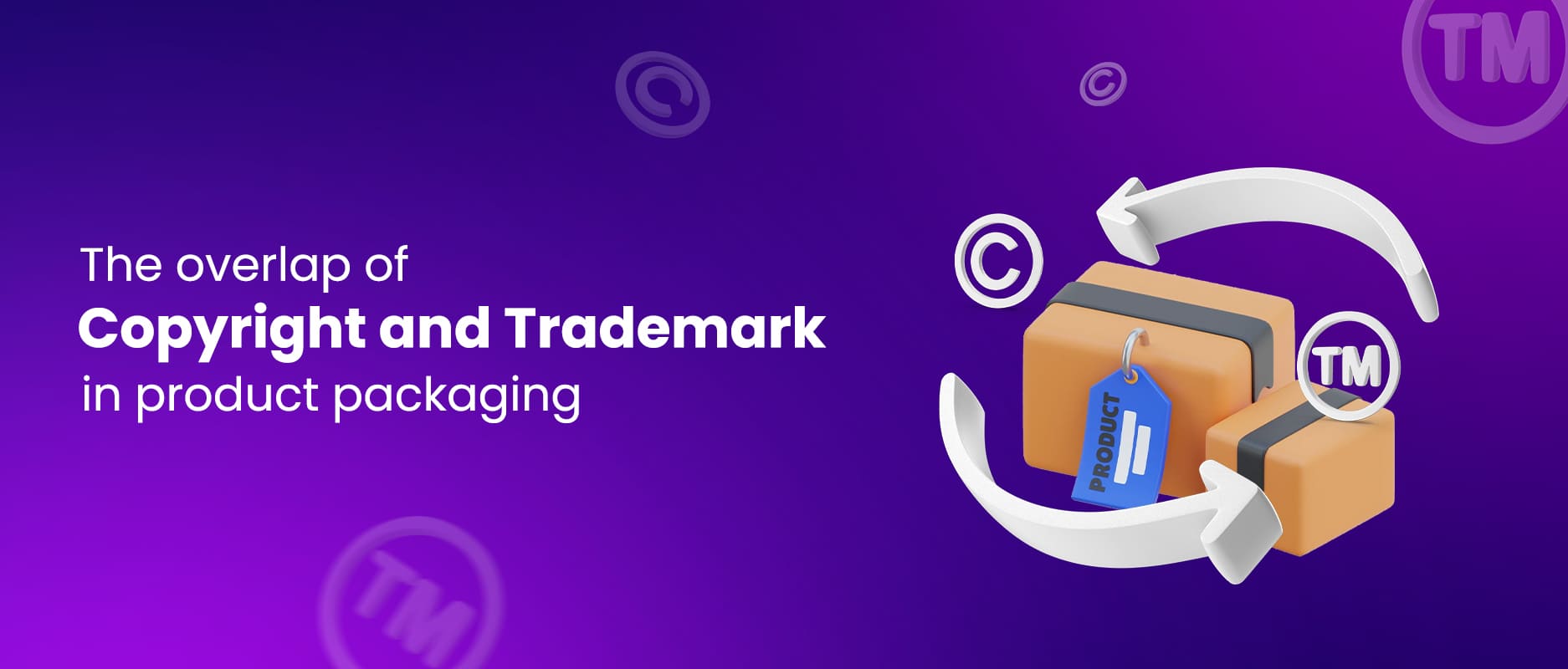The Overlap Of Copyright And Trademark In Product Packaging
October 14, 2025 By Sonal BhattProduct packaging isn’t just about utility - it’s also a canvas for branding, artistry and legal protection. But from an intellectual property (IP) perspective, packaging sits at a fascinating intersection of Trademark Law and Copyright Law. Brands, designers, lawyers and entrepreneurs must understand how Trademark in Product Packaging and Copyright in Product Packaging overlap, and where they diverge.
In this blog, we’ll explore:
- What each IP regime protects in packaging
- How they overlap (and where tensions lie)
- Real-world Indian and international examples
- Practical tips and FAQs
What Each Right Protects
Trademark in Product Packaging
Under Trademark Law, a brand can protect signs, logos, colours, shapes, and even the “trade dress” or overall visual appearance of packaging that identify the source of goods to consumers. The essence is distinctiveness and non-functionality.
- A colour scheme or combination (if it has acquired secondary meaning)
- A distinctive shape or form of packaging (bottle shape, box structure)
- A logo or device mark printed on the package
- The overall “look and feel” or trade dress
For instance, the contour Coca-Cola bottle is a classic example of a shape mark protected by trademark law (because it is distinctive and not functional).
In India, courts have recognized that packaging (“get-up”) can be part of the trademark protection. For example, the Karnataka High Court in ITC Limited v. CG Foods discussed how the overall packaging or “get-up” may be protected under trademark law.
Also, Indian courts have enforced injunctions such as when packaging is too similar to an established brand. In one case involving Britannia’s “Good Day” cookies, the Delhi High Court restrained a rival from using a blue-yellow packaging and name “Good Times” because the defendant’s packaging was confusingly similar.
Trademark protection continues so long as the mark is used and renewed (in India typically ten years at a time) and if it continues being distinctive.
Copyright in Product Packaging
Copyright Law, on the other hand, protects original works of artistic expression fixed in a tangible medium. In the context of packaging, this means:
- Artistic elements (illustrations, drawings, photographs, graphic designs)
- The selection, arrangement, and layout of graphic elements
- Unique 3D sculptural features (if creative enough)
Note: Copyright does not protect titles, slogans, names, or short phrases (these are normally too minimal or more of a trademark domain). Also, purely functional aspects or generic designs (geometric shapes, basic colour blocks) without sufficient creativity will typically be excluded.
For example, if a brand uses an original, stylised illustration of a landscape or a creative mascot, that artwork on the packaging may be safeguarded by copyright.
Moreover, even when the individual elements are not novel, if the combination and layout reflect creative choices, that “selection and arrangement” might be protectable under copyright law.
Where the Overlap and Tension Occur
Because packaging often combines branding and artistry, there is overlap, and sometimes conflict between Trademark in Product Packaging and Copyright in Product Packaging.
Overlap Areas
- Logo artwork
- The same logo printed on packaging can be protected under both trademark (as a mark) and copyright (as an artistic work).
- The trademark keeps others from using confusingly similar logos; copyright prevents copying of the exact graphic.
- Distinctive packaging design
- If a packaging design is so original that the entire design qualifies as an artistic work, it may get copyright.
- Simultaneously, if the design is distinctive and non-functional, it could qualify for trade dress protection under trademark law.
- 3D sculptural elements
- Suppose a perfume bottle has a unique sculptural form. That form might be protected by trademark (shape mark) and also by copyright (as a sculptural work) if sufficiently original.
Tensions and Boundaries
- Functionality doctrine
Trademark/ trade dress protection rejects aspects that are purely functional (i.e. essential to the use or cost of the goods). A shape that improves handling or reduces cost is disallowed as a trademark.In contrast, copyright does not protect functional features either - only expressive, non-utilitarian aspects. - Threshold of originality
Many packaging designs consist of simple geometric patterns, shapes, or colour blocks. Such minimalistic or generic elements may fail the threshold of originality for copyright, and also may lack distinctiveness for trademark protection. - Duration and enforcement
- Copyright typically lasts life of the author + 60 years (in India)
- Trademark can be renewed indefinitely if still in use
- Enforcement strategies differ (infringement actions, passing off, cease & desist, etc.)
- Ownership and licensing
Ownership of the trademark and ownership of the copyright may lie in different entities. For example, a packaging design agency might hold copyright in the design, whereas the client holds the trademark. Clear agreements are essential.
Real-World Examples
Example: Parle v. Future Group (Bombay High Court)
In a well-cited Indian case, the Bombay High Court upheld copyright protection for the packaging of Parle’s biscuits (Monaco, Krackjack, Hide & Seek) against infringing packaging.
Here, the court recognized that the creative arrangement / selection of visual elements on the packaging was deserving of copyright protection, in addition to possible trademark/trade dress rights.
Example: Gopal Snacks Raid
In 2025, the Bombay High Court ordered raids in a trademark + copyright infringement case filed by Rajkot-based Gopal Snacks. The plaintiff alleged that other entities were using deceptively similar packaging to exploit its registered “Gopal” trademark.
This case illustrates how plaintiffs often bring parallel claims under trademark (for source confusion) and copyright (for copying creative packaging portions) in India.
Example: Ferrero vs. M.B. Enterprises
Ferrero (maker of Ferrero Rocher, Nutella, etc.) obtained relief in a trademark suit in India against a local company for allegedly infringing its trade mark rights via packaging similarity.
While this is more about trademarks, it underscores how global brands vigilantly guard their packaging image as part of their identity.
Example: Aldi / Baby Bellies (Australia)
In a 2024 decision, an Australian federal court found that Aldi had committed copyright infringement by copying elements of rival brand Baby Bellies’ packaging (a cartoon owl design) even though Aldi had made modifications. The court called Aldi’s conduct “flagrant.”
This illustrates how protective courts can be of the expressive “look and feel” of packaging when the copying is substantial.
Example: Nestlé vs. Cadbury (shape mark attempt)
Cadbury attempted to trademark the shape of Nestlé’s KitKat bar packaging, but Nestlé successfully opposed it, showing the difficulty of gaining trademark rights in shapes when they lack distinctiveness or are too functional.
Practical Tips for Brands & Designers
- Design with differentiation in mind
Avoid layouts or design motifs that mimic competitors. The more distinct your packaging, the stronger your chances of protection under both Trademark Law and Copyright Law. - Document creative process
Keep drafts, dated sketches, design files, these help in proving originality in a copyright claim. - File for trademark protection early
Register logos, colour schemes, shapes, and trade dress where possible. In many jurisdictions, registration strengthens your legal position against infringers. - License rights explicitly
If you outsource packaging design, make sure the contract clearly assigns copyright and grants you trademark use / ownership. - Watch for “look-alikes”
Even if a rival changes small elements, courts may assess whether the overall impression is confusingly similar. Be vigilant and enforce rights timely. - Clear overlap claims
In enforcement, you can (and often should) bring parallel claims under trademark law (for confusion) and copyright law (for copying).
FAQs
Q1: Can I rely on copyright only and skip trademark registration?
You can rely on copyright for the expressive elements of your packaging (if original). But copyright won’t protect your brand identity (name, logo) or prevent competitors from using lookalike marks. Trademark registration gives you stronger tools (cease & desist, damages, domain rights) for brand protection.
Q2: If someone copies my packaging layout but changes colours, is that infringement?
It depends: under Copyright Law, courts may ask whether what’s copied is a substantial portion of the creative expression. Minor changes may not suffice if the “heart” of the design remains the same. Under Trademark Law, even if colours differ, the question is whether there’s confusion in trade.
Q3: Can I trademark a color?
Yes, in certain circumstances (if the color scheme acquires distinctiveness and is nonfunctional). But color alone is difficult to register; more often, color combinations or color + mark are protected.
Q4: What if packaging is mostly functional (ease of opening, structural box)?
Trademark protection will likely fail on functional features, because trademark/trade dress cannot monopolize useful features. Copyright also does not cover purely functional aspects, only expressive/nonfunctional designs.
Q5: How long do the protections last?
- Copyright: in India, the term is life of author + 60 years (for artistic works).
- Trademark: must be renewed (in India, typically every 10 years) and kept in use to maintain protection.
Conclusion
Product packaging sits at a sweet spot between brand identity and creative expression. Trademark in Product Packaging shields what consumers see as the brand’s signature, while Copyright in Product Packaging protects the unique artistic content. When leveraged together smartly, they give brands a powerful defense against copycats, imposters, and design leeching.
That said, packaging IP is also a legally nuanced space - the functional vs expressive distinction, thresholds of originality, enforcement strategy, and jurisdictional differences all matter.





